All 15 entries tagged Undergraduate Research
No other Warwick Blogs use the tag Undergraduate Research on entries | View entries tagged Undergraduate Research at Technorati | There are no images tagged Undergraduate Research on this blog
September 01, 2016
Decius' Divi: Facebook for the Emperor
The Emperor Decius came to power in late AD 249 having killed his predecessor, Philip the Arab, in battle (Potter 1990, 40-45). This manner of succession was far from unusual for the period. By this time no Roman emperor had died of natural causes for a little over a hundred years. As such a Roman citizen could be forgiven for believing their new leader’s reign would be as short, and end as messily, as those that had filled the preceding century. Whilst said cynical citizen would have been entirely correct (Decius and his son were killed in a swamp fending off marauding Scythians a mere two years into his reign according to Zosimus) this was not an opinion the new emperor was keen to encourage. As such he commanded all citizens to make sacrifices to the gods for the health and stability of the empire and concurrently issued a series of coins, now known as the ‘Divi series’.

Antoninianus minted at Mediolanum (Milan), RIC IV Trajan Decius 77
This series of coins is remarkable because they do not, as we would expect, feature the image of the new emperor – a feature we know provincials regarded as distinctive in Roman (as opposed to local) coinage (Mark 12:17). Instead on the obverse they picture the faces of eleven of his predecessors, crowned with radiate crowns; Augustus, Vespasian, Titus, Nerva, Trajan, Hadrian, Antonius Pius, Marcus Aurelius, Commodus, Severus and Alexander (Ando 2000, 209). The image on the reverse of the coins varies, however most commonly they feature either an eagle (a representation of apotheosis, perhaps most notably seen on the Arch of Titus in Rome) or an altar – presumably to the divine emperor shown on the obverse. This is reinforced by the coins’ respective legends which, on the obverse, give the pictured emperor’s name with the prefix ‘Divo’, meaning divine, and on the reverse read ‘consecratio’, meaning consecrated. Notably we have examples of these coins from mints across the empire, not just from Rome, suggesting that Decius was keen for them to be viewed by as large a number of people as possible. They would seem to be the Roman equivalent of a public Facebook post, rather than a message meant for those immediately around the new ruler.
Imperial portraits also played a key role in the sacrifices Decius demanded for the empire’s continued stability. Whilst the deities sworn to varied from town to town across the empire’s provinces (Tertullian To the Nations 2.8.7), with Roman religion being flexible enough to incorporate local deities from far flung reaches of the empire, each ceremony was enacted before a series of imperial statues, perhaps even in some contexts the same emperors featured on the coinage (Ando 2000, 209). The message Decius hoped to deliver is clear. Here were a group of exceptional, and deified, emperors who moved the empire forward. He would be the next in the ‘canon’ of greats and a citizen of Rome was secure under his rule.
Moreover Decius was emphasising the power of the emperor. On his later coinage various Roman mainstays are depicted, but divine figures are almost entirely absent (Mattingly 1924). By presenting his predecessors as essential figures in Roman religion, to the detriment of the traditional pantheon, Decius promoted his office as something quasi-divine and by association raised himself above the concerns of petty mortals. If successful this public relations initiative could only have increased his authority and hold on an increasingly fractious state. It was also something of a change from the policy of his immediate predecessor who, as discussed in last month’s blog, was sympathetic to Christianity – a religious creed incompatible with the Imperial Cult.
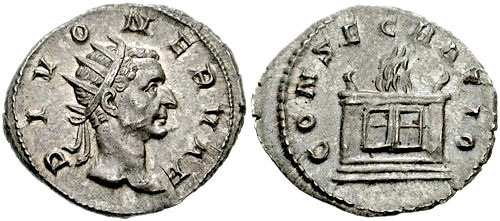
Antoninianus minted at Mediolanum (Milan), RIC IV Trajan Decius 84b
So what kind of an impact did Decius’ Divi have? Whilst we cannot be sure we can be confident that his coinage was well known by later Romans. Gregory of Tours, a sixth century historian and bishop tells us that seven young Christians (and their dog) fled to a cave to escape persecution for refusing Decius’ edict to sacrifice to the pagan gods (Lane-Fox 1986, 450, 490). Naturally they then fell asleep for nigh on two centuries, awakening in the Christian empire of Theodosius II. When one of their number left cave to buy food the coinage he used was immediately recognised as from the time of Decius (Ando 2000, 227), which provoked wonder amongst the town’s folk – wonder presumably compounded when the sleepers all promptly fell dead (Gregory of Tours, Passio septem dormientium 7-8). Whilst the story itself isn’t terribly believable it likely grew in the telling from events that truly happened. It is not so hard to imagine Christians fleeing rather than submitting to the emperor’s edict, indeed reactions to said edict were a subject of much later controversy within the church (Lane-Fox 1986, 550). Moreover if those Christians were to have fled with any money it doesn’t seem beyond the realms of possibility that the emperor’s newest coinage would have featured prominently in their collections. If a cache of their belongings were later discovered and spent there would have been a sufficient framework for the myth to have grown. Whilst there’s a fair amount of conjecture there I like to think that Decius’ Divi were still being recognised two centuries after his death and were being talked about by even later historians.
 |
This month’s coin entry was written by Ben Howarth. Ben is about to begin an MA in the Department of Classics and Ancient History at Warwick. He has an interest in the development of Christianity in the Roman Empire and his undergraduate dissertation was on the persecutions of ‘others’ by Christians in the late 4th and early 5th centuries – an interest he hopes to develop further during his MA.
Bibliography:
Coin images reproduced courtesy of Numismatica Ars Classica (Auction 33, ot 404), and Classical Numismatic Group Inc., (Mail Bid Sale 66, lot 1420) (www.cngcoins.com).
April 01, 2016
Crocodilian influences on the denarius of 28 BC
 |
| Denarius of Augustus from 28 BC. |
The first recorded time a crocodile appeared on a Roman coin was 37/36 BC, under the authority of M Licinius Crassus, an official who had authority over the Greek island Crete and the African region of Cyrenaica. Scholars have attempted to claim that this was the son of the triumvir Crassus who in 53 BC famously conducted the Parthian disaster. The historical content of the Crassus coinage is dubious and complicated but it would be fair to assume and accept scholarly debate that his crocodile represented renewed Egyptian authority over Cyrenaica, an honour that was ceded to the Ptolemaic ruler Cleopatra VII by the cunning Marc Antony.
However, when Augustus utilised the crocodile on his coinage it was as a focal point of celebration towards Rome’s acquisition of Egypt and revered his military triumph. The crocodile interestingly could serve as a sign of continued power and dynastical tenure or the polar opposite of capitulation. With the caption of ‘Aegypto capta’; ‘captured Egypt’ we are able to understand the multi-faceted potential of a crocodilian representation and how the crocodile signified power dependant on the way it was utilised .
To understand the sole purpose of the crocodile on the denarius of 28 BC would be enormously difficult. Commonly in Egyptian practice, crocodiles were to supposed to allude to, and be associated with, their relationship to the river god Nilus, from whom Egypt’s affluence and prosperity was supposedly derived. The crocodile was the epitome of Egyptian power and was typically indigenous to the Nile so it often acted like a glorified mascot. Augustus had left his use of the crocodile imagery purposefully open to interpretation so that it could represent the formidable animal in which the Romans were so curious about, and were so proud to have enslaved, because it embodied the fate of Egypt. Or did it signify and celebrate the prosperity of Egypt through the crocodile’s relation to Nilus?
The best insight into the truth is the coinage of the colony of Nemausus (Nîmes) struck under Augustus: here a crocodile is depicted chained to a palm tree and is undeniably the sign of Egypt subdued to the power of Rome and presumably is a continuation of attitude from the denarius of 28 BC. The obverse of the denarius of 28 BC, a bareheaded and heroically unadorned bust of Augustus, has a protuberant brow alongside a wry smile which is meant to reaffirm the legitimacy of his autocratic reign by reasserting his military success, ultimately bringing us back to the subject of power. The crocodilian imagery on these coins was a boast of power, eastern luxury, but more importantly, it was who wielded and subjugated the crocodile that decided who the ancient beast would transfer its power to.
 This month's coin was written by Alfred Wrigley. Alfie is a second year ancient history and classical archealogy student who is hoping to specialise in and write his dissertation on Julio Claudian coinage.
This month's coin was written by Alfred Wrigley. Alfie is a second year ancient history and classical archealogy student who is hoping to specialise in and write his dissertation on Julio Claudian coinage.
Coin image reproducted courtesy of the Trustees of the British Museum.
March 01, 2016
The Proculus Enigma: Have the history books been telling it wrong?
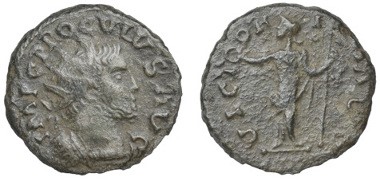 |
| Figure 1: Proculus Billon ‘Radiate’ (2.96g, 19.27mm) |
Before discussing this particular coin of the month, please forgive the Herodotus-esque digression on the context of its appearance. The day was November 7th 2012, and it began much like every other for one Yorkshire metal detectorist. The site he had chosen for the day had produced numerous finds in prior visits, most of which had suggested that he was walking in the footsteps of his Romano-British forebears. At this point, a thought may even have crossed his mind that his next find might be something other than Roman ‘grot’(derogatory archaeological slang for a heavily corroded and illegible Roman (typically) coin). Yet one object was, and all it took was just one signal, one hole, and one turn of the spade to unearth something virtually unique. However, this was not realised by the finder, Colin Popplewell, until he had posted images to an online forum. Further unbeknownst to him, his chance discovery would reignite a debate over the very existence of a third century usurper, and the contentious issue of his having struck coinage. The coin he found (Fig.1), provided an overt reference to a character by the name of Proculus having assumed the imperial purple. The legend reads:
IMP C PROCVLVS AVG // VICTORIA AVG
Emperor Caesar Proculus Augustus // Victory of the Emperor
This legend has only appeared once previously on a coin from a German collection, sold in 1991. Given its inherent rarity, it was unsurprising that this latest find was first met with scepticism, and then denunciation as a later forgery by some academic circles. However the author recalls a remarkably similar scenario occurring in the case of another usurper: Domitianus II. This case was only resolved in 2003, when a hoard from Chalgrove, Oxfordshire securely contextualized a coin bearing Domitianus’ name. Whilst a scenario such as this is yet to arise for Proculus, the reliable context of this second discovery compels my subsequent analysis to be conducted on the presumption that both examples are genuine.
 |
| Figure 2: Both coins superimposed |
With only two coins, it would seem extremely difficult to produce a convincing argument for reinvestigation. However by overlaying images of one coin on top of the other, it is immediately apparent that the obverse and reverse designs are identical (Fig. 2). To a numismatist, this is a definitive indication that the same pair of dies produced both coins. This also strongly suggests that they were produced at the same workshop, if not even by the same hand (Morgan 2006: 175. For Domitianus II die linkages also proved crucial in authenticating both coins). Furthermore, the presence of intelligible legends on these two coins must indicate that they are also the product of a literate manufacturer. This particular factor also questions their potential alternative identification as so-called “barbarous radiates” (which also happened to be in contemporary circulation). However, most of these coins were low-grade imitations of official currency, and were seemingly produced by local, illiterate satellites. Consequently, the only plausible conclusion to draw from this appraisal of Proculus’ coinage is that they resemble the products of a coordinated and sanctioned series.
Having therefore established credentials for our coin, an assessment of other extant material can now be made, to establish whether this additional numismatic evidence for Proculus conforms to our historical impressions of the individual. The iconography of the coin itself helps to narrow our search of literary material to the later third century AD. This is evident from the size of the coin and the depiction of a radiate crown, which is emblematic of this period. Our main historical record for this period is the Historia Augusta, which is unfortunately notorious for its fabrication of stories (Dessau 1899). On account of its reputation, it is therefore unsurprising to find that it has provided two conflicting accounts for the character of Proculus. The first has him revolt in Cologne during the reign of the Emperor Probus (HA Life of Probus XVIII.5), whilst the second records his rebellion occurring in Lyon (HA Lives of Firmus, Saturninus, Proculus and Bonosus I.4, XIII.1). Other surviving references to Proculus are more questionable on account of their even later publication dates (Eutropius IX.17, Epitome de Caesaribus XXXVII.2). Consequently as the literary source most contemporary to the life of Proculus, the Historia Augusta must be consulted in contextual discussion of these enigmatic coins.
“One fact, indeed, must be known, namely, that all the Germans, when Proculus asked for their aid, preferred to serve Probus rather than rule with Bonosus and Proculus.”
HA Life of Probus XVIII.7
This suggests that Proculus usurped during the reign of Emperor Probus alongside a figure by the name of Bonusus, although no such indication of this partnership is given on our coins (the recognised dedication for multiple rulers is expressed by the number of Gs in ‘AVG’ - Proculus’ coinage has just one). More significant though, is the explicit mention of a location that accords with the find-spot of this latest example. Proculus is documented as having claimed the province of Britannia along with Gaul during his usurpation (HA Life of Probus XVIII.5), thereby assuming control of the Legion stationed in York (near to the site of the coin’s eventual deposition). However, in the view of the author, if the revolt had occurred during the reign of Probus, our examples of Proculus’ coinage would be stylistically out of date. This is owing to a coin reform enacted by Probus’ predecessor Aurelian, during the middle of AD 274 (Carson 1965, Weiser 1983). Alongside the addition of mintmarks and marks of metal or face value, the style of imagery depicted notably changed. Comparing the pre- and post-reform currency of Aurelian clarifies this point further, (Fig. 3 and 4) as design focus visibly shifts away from large draped busts to depictions of elongated necks wearing cuirassed attire. Whilst usurpation may have led to cessation of contact with the Empire, knowledge of monetary design appears to spread unaffected. Confirmation of this can be found in the usurper Saturninus, who apparently revolted in the East at the same time as Proculus did in the west (HA Life of Firmus, Saturninus, Bonosus and Proculus). His coinage (Fig. 5) depicts significant iconographic similarities to Aurelian’s reformed coinage, as the long neck and military uniform are his most noticeable features. Had Proculus’ rebellion been contemporary to Saturninus, one would expect to see more stylistic similarities between the two series. However, their style remains notably different, with Proculus’ strong facial dominance being more akin to pre-reform types. Consequently, iconography forces us to consider the possibility that Proculus coined, and thus usurped, much earlier than the literary sources suggest; prior to the Summer of AD 274.
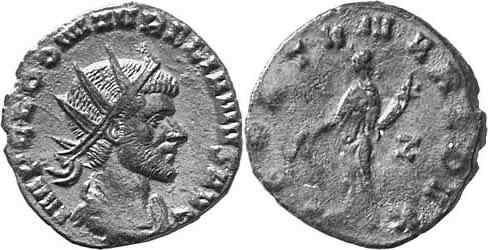 |
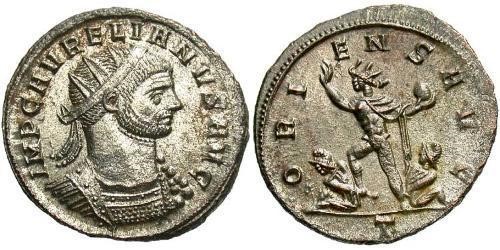 |
| Figure 3: Pre-reform issue of Aurelian |
Figure 4: Post-reform issue of Aurelian
|
|
|
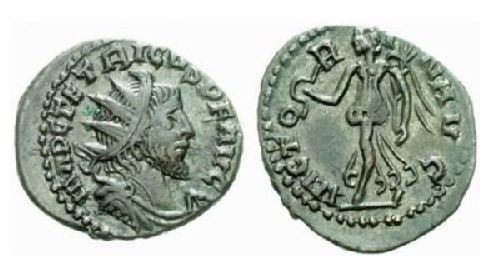 |
| Figure 5: AV Aureus of Saturninus |
Figure 6: Antoninianus of Tetricus
(AD 270-3), VICTORIA AVG, RIC V.2 141
|
Pursuing this theme further identifies a striking iconographic relationship between Proculan types and Tetrican coinage of the late Gallic Empire (AD 271-4). The depiction of a radiate crown alongside the stylistic rendering of the hair and beard seem, at first glance, to be virtually indistinguishable. There is however an unusual feature to Proculus’ coin that challenges the combination of the reverse legend and the personification depicted. The legend being whole on the new discovery confirms the personification to be related to ‘victory’. However there appears to be no reflection of Victoria’s most recognisable attribute (wings) on the figure itself. Yet, similarly dedicated Tetrican issues clearly depict these iconic wings alongside the legend (Fig. 6). The author however notices the remarkable similarity of Proculan imagery to Tetrican representations of Pax [Peace] (Compare Fig. 1 and 7). If such confusion is a sign of ignorance on the part of the die engraver, the rest of the coin design reflects only overt and literate skill. Consequently, iconology allows us to isolate a distinct relationship between the coinage of the Tetrican dynasty and Proculus, furthering the contention for a revisal of our current date for his revolt.
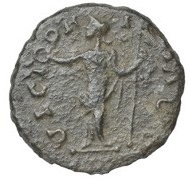 |
 |
| Figure 1: Proculus reverse |
Figure 7: Tetricus Antoninianus
(AD 270-273) PAX AVG reverse
|
Intriguingly our other surviving literary reference to Proculus affirms this idea, by bizarrely also recording his revolt during the reign of the Emperor Aurelian:
“…to see to it that … Bonosus and Proculus and Firmus, who revolted under Aurelian, be not be passed over in silence.” (HA I.4)
Given this new date, earlier accounts need reappraisal in order to identify whether available evidence has been overlooked or even originally misrecorded. Given the previous association of Tetrican and Proculan coinage, the histories recounting the fall of Tetricus and the end of the Gallic Empire are of particular interest. They document how the Gallic usurper defected to Aurelian as a consequence of his inability to control his Legions’ ‘evil deeds’ (HA Life of Aurelian XXXII.3). The ambiguity of this account is problematic, as too is the implausible scenario of Tetricus simply defecting to Aurelian on account of his failure to discipline his army. Moreover, numismatic evidence clearly suggests that Tetricus had dynastic intentions for his own household, as he produced coins in the name of his son. This can only be perceived as a view to dynastic succession, thus directly contrasting with the notion of a voluntary, uncontested surrender. However, later histories allude to a mutiny within his legions at this time (Eutropius IX.13.1), and even the establishment of a rival usurper by the name of Faustinus (Aurelius Victor XXXV.4). Zonaras even adds that Aurelian succeeded in suppressing this usurper soon after receiving the surrender of Tetricus (Zonaras XII.27). Mutiny thus provides a more plausible explanation for Tetricus' surrender, as it implies that his actions were out of compulsion.
However the overall narrative is confounded by a lack of reference to the usurper “Faustinus” at any point in the Historia Augusta. Yet every indication from later sources imply that his reign lasted up to several months, easily affording him time to produce currency, especially if accounts accurately record the revolt at the Gallic mint site of Trier (Konig 1981: 181). Yet no such coins have ever appeared in the name of Faustinus and no account is provided for him in our most contemporary and complete text on third century Gallic usurpers. This history, however, strikingly resembles the picture thus far painted from a study of Proculus’ coinage. As previously argued, the idea of Proculus being the rival usurper who drove Tetricus out in AD 274 also fits significantly better with the coin iconography he displays. Such a narrative would also account for the significant rarity of Proculus’ coinage, as Aurelian was already marching on Gaul to remove Tetricus at the time of this subsequent revolt. Circumstantial evidence may therefore tempt us to entirely replace the character of Faustinus with Proculus, but neither exists on mutual exclusivity. Nevertheless, literary material still allows us to tentatively advance our knowledge on the figure of Proculus. Histories clearly indicate that a revolt occurred in Gaul at the end of Tetricus’ reign, prompting his downfall. Given the further existence of textual and iconographic data that plausibly attribute Proculus’ rebellion to this time, and to this location, Colin Popplewell’s find provides us with a new and significant opportunity to reconsider the date for this most enigmatic of usurpers.
Must it truly take one coin, in one hoard, to truly return Proculus to the annals of history?

Written by Greg Edmund, an Undergraduate Finalist at the University of Warwick, studying Ancient History. His interests are in Ancient and Medieval Numismatics.
Bibliography:
Carson, R.A.G (1965) ‘The reform of Aurelian’, Revue Numismatique, Vol.6, No. 7, pp225-235
Dessau, H (1889) ‘Uber Zeit und Personlichkeit der Scriptores Historiae Augustae’, Hermes 24, pp337-392
König, I (1981) Die gallischen Usurpatoren von Postumus bis Tetricus (München)
Morgan, L (2006) ‘Domitian the Second?’, Greece and Rome Vol 53, No.2, pp175-184
Weiser, W (1983) ‘Die Münzreform des Aurelians’, Zeitschrift für Papyrologie und Epigraphik, 53, pp279-295
Figures:
Figure 1: DNW Auction (10 April 2013) Lot 694.
Figure 2: Umberto Moruzzi and Fabio Scatolini ‘The usurper Proculus and his coinage’, Coins Weekly [Accessed: 30th January 2016)
Figure 3: Aurelian pre-reform radiate: RIC 29 (http://www.wildwinds.com/coins/ric/aurelian/RIC_0029.jpg) [Accessed: 22nd February 2016]
Figure 4: Aurelian post-reform radiate (http://www.coinshome.net/) [Accessed: 22nd February 2016]
Figure 5: Dirty Old Coins (http://www.dirtyoldcoins.com/roman/id/Coins-of-Roman-Emperor-Saturninus.htm) [Accessed: 30th January 2016]
Figure 6: Wildwinds (http://www.wildwinds.com/coins/ric/tetricus_I/RIC_0141.1.jpg) [Accessed: 30th January 2016]
Figure 7: Wildwinds (http://www.wildwinds.com/coins/ric/tetricus_I/RIC_0100.jpg) [Accessed: 30th January 2016]
October 01, 2015
The elephant denarius of Julius Caesar
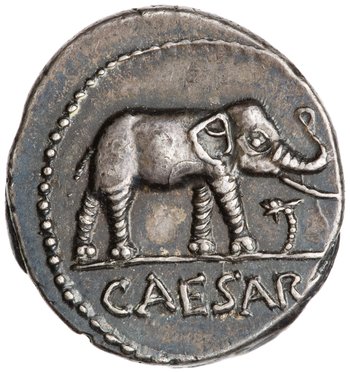 |
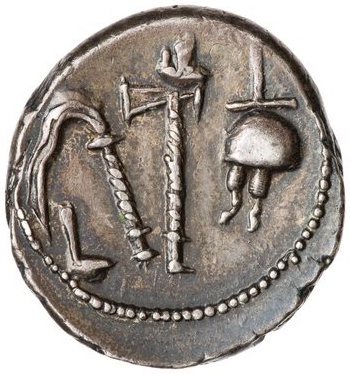 |
Silver denarius of Julius Caesar (RRC 443/1)
One of Julius Caesar's most famous coin issues is the ‘elephant denarius’. The reverse features a group of religious symbols: a culullus, aspergillum, an axe decorated with animal imagery, and an apex. On the obverse, the denarius shows a right facing elephant with the word "CAESAR" in the exergue. An estimated 22.5 million pieces were minted, making this coin the third most frequent in the Republican era and adequate to pay eight legions. It is often dated to 49 B.C, the year Caesar took large quantities of gold and silver from the treasury in the Temple of Saturn in Rome. This metal was probably used to fund his new denarius. The date is one among the questions about the coin that continue to be debated. Other undecided issues include what the elephant is standing on.
The elephant may symbolize Caesar's Gallic campaign against Ariovistus in the battle of Vosges in 58 BC, especially if the object on which the elephant treads is a Gallic war trumpet. But this object could arguably be a snake, meaning that the coin communicates the victory of good over evil. Among other propagandizing purposes, it could have been intended to humiliate the self-important and supercilious Pompey, who had tried to associate himself with Alexander by riding a symbol associated with Alexander the Great, the elephant, in his triumphal procession. Pompey had, embarrassingly, failed to actually manoeuvre the animal into the city. The image might represent the snake as a natural enemy of the elephant.
The religious symbols associate Caesar with his prestigious pontifical position as the head of Rome's religious hierarchy. Caesar had been Pontifex Maximus since 63 B.C. The symbols are similar to the augural ones that are more common on Republican Roman coins, including the lituus. Because Caesar did not become an augur until 47 B.C, and since the coin is dated to, at the earliest, the 50s, or more likely 49, it should be noted the symbols here are not augural.
However the view of some scholars suggest that the imagery of the elephant suggests that Julius Caesar considered himself on the same footing as famous military generals such as Alexander the Great and Hannibal.
 |
This month's coin was written by Alfred Wrigley. Alfred is a 2nd Year Ancient History and Classical Archaeology student with great interest in Julio-Claudian Numismatics and is hoping to specialise in numismatics of Julius Caesar.
Coin image reproduced courtesy of the American Numismatic Society.
May 01, 2015
In the shadow of a dictator
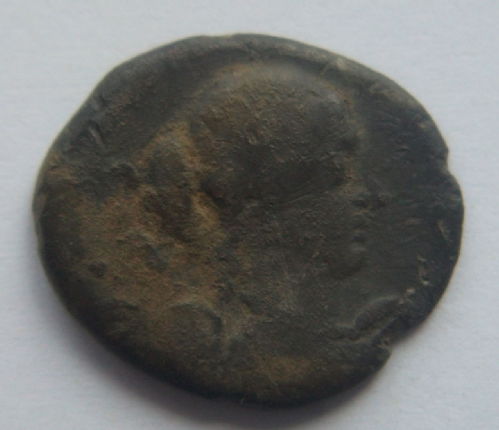 |
 |
Coin of Titus Carisius
Obverse: Victoria right, SC behind. Reverse: Victory driving a Quadriga, T.CARISI in exergue (Sydenham 985, Crawford 464/5)
If one were to poll 100 individuals about the name ‘Titus Carisius’, all 100 would be forgiven for having never heard of him. His appearance in the Roman Republican monetary record is simply overshadowed by the folklore popularity of contemporary figures such as Pompey the Great and Julius Caesar. Even Roman historians only briefly record the exploits of the gens Carisia, the lineage from which Titus descends. Cassius Dio refers to a ‘Titus Carisius’, presumably the same individual as our moneyer, defeating the native Astures in the province of Hispania and founding a colonia there (Dio LIII.25.8). However, the later historian Florus records the same feat of 25BC as the exploits of a legate with the praenomen ‘Publius’ not ‘Titus’ (Epitome II.33; Florus lived from c. 70 – 140 AD). It would appear from the subsequent coinage of the new colonia founded for the Legio V Alaudae and Legio X Gemina that Florus was correct in his documentation as coin legends clearly record P. CARISI as the legate and pro-praetor. Such confusion therefore compounds the disappearance of Titus Carisius from history. This article seeks to re-establish this forgotten triumvir monetalis of 46 BC alongside the recognizable names of the period, by evaluating one example from the fascinating series of coins he produced.
The actual coin used in this article is a recent discovery from Britain that has inspired this piece. At first glance it would appear to most as an ordinary example of Republican coinage, displaying the personification of a goddess on the obverse with a symbol of Republican Rome on the reverse. In this case it depicts a quadriga (4-horse chariot); a symbol used on the earliest denarii of 211 BC. This traditional symbol twinned with a goddess here would not look out of place amongst those late 3rd century BC issues, were it not for the goddess depicted on our coin. The personification of Victoria with the legend S.C adorns the coin’s obverse, a symbolization therefore of a victory commemoration.
History does not record a triumph of the gens Carisia in 46 BC when this coin was struck, nor is there a documented history of the Carisian line before the mid 1st century BC. So it is unlikely this coin issue commemorates a family victory. It must therefore herald the victory of a contemporary event or figure - Julius Caesar. Such a conclusion should not be remarkable, considering Caesar had just been declared a dictator for ten years. He was therefore well-known, holding a position of direct and indirect influence over the coinage minted. Another known type of Titus Carisius depicts a cornucopia above a globe with a sceptre and rudder on either side (Crawford 464/3A). Such imagery evokes ideas of wealth and prosperity over the globe, with the rudder acting as a guide. This is comparable with Caesar’s accomplishments in annexing Gaul and forays to Britain in the previous decade.
Furthermore, connections between the quadriga-issue and a Caesarian triumph can be identified when Caesar’s own coin types are considered. It is widely accepted that Caesar continued his own coin production from his moving Spanish mint in 46 BC, striking types that reference his victory in the bello gallico of 58-50 BC (See RSC 13; Sydenham 1014; Crawford 468/1). Further links between the two can be found from an inscription (Figure 1) discovered in Avignon in 1841 believed to date from the third quarter of the 1st century BC (see Christol, M: Une nouvelle dédicace de T(itus) Carisius, praetor Volcarum, près d'Ugernum (Beaucaire, Gard) 2005 for more information). It briefly records a “Titus Carisius, son of Titus, Praetor of the Volcarum”, leading to speculation that Titus may have been the son of a soldier of the Volques tribe of Southern Gaul, granted Roman citizenship during Caesar’s time. This offers a potential explanation for a lack of records for a gens Carisia prior to the 1st century BC and even circumstantial evidence of historical connections between a character likely to be our moneyer and Caesar. Therefore it is by no means a stretch of the imagination to compare their coinages.

Figure 1: Avignon Inscription (Wikimedia Commons)
The reverse of our coin has similar Republican-themed imagery, with an unmistakable figure driving a quadriga with T.CARISI beneath in the exergue. Once more the personification of Victory appears, again suggesting that this coin’s message of victory is too forceful to be unintentional – hinting at the fusion of existing Republican iconography with contemporary Caesarian ideology. On reflection, this may provide the ultimate reason why ‘Titus Carisius’ has been virtually erased from history. The fact this coin type is so similar to many other Republican issues, as well as being loaded with Caesarian propaganda, aided Carisius’ disappearance. However one factor remains that explains how I am able to write such an article upon Carisius’ coinage - his name. The very fact that Titus Carisius ascribed his own coinage, a standard practice among Republican moneyers, gives us a small window into the dying days of the Republic, a time clearly dominated by the actions of one man and his heirs. Yet this coin offers more; it provides insight into the actions and presumably the aspirations of other forgotten members of the ruling classes. Does this coin, however subtly clouded in Caesarian propaganda, radiate a hope for the restoration of earlier Republican values by utilizing an established coin design, or does it simply confirm the acceptance of a dictator? However likely the latter is from the available evidence, the true meanings of the coin have unfortunately been lost to the passage of time. I am however certain of one thing… I’m glad he left us his name.
 Written by Gregory Edmund, currently a 2nd Year Undergraduate studying Ancient History at the University of Warwick. His main interests lie in Republican Roman coinage (after 211BC) as well as Iron-Age and Roman Britain.
Written by Gregory Edmund, currently a 2nd Year Undergraduate studying Ancient History at the University of Warwick. His main interests lie in Republican Roman coinage (after 211BC) as well as Iron-Age and Roman Britain.
April 01, 2015
The coin that killed Caesar?
It is the 15th of March 44 BC, and as Julius Caesar sets forth from the threshold of his house to commence his journey to the Theatre of Pompey to convene with the Senate, he has no idea that he will not return later this day. Never would he have imagined that his life would come to such a brutal and bloody end at the hands of those he deemed so close to him. Indeed, as Plutarch informs us, the man was stabbed a total of 23 times by various senators, all so incredibly eager to partake in this momentous event in history that “many of the conspirators were wounded by one another, as they struggled to plant all those blows in one body” (Plutarch, Caesar, 66). To say that Caesar’s assassination was a veritable bloodbath would be a mere understatement. Well, what if I were to tell you that one of history’s most infamous murders could have been motivated by a single coin?
 |
|
Denarius with portrait of Julius Caesar on the obverse (RRC 480/3)
|
In the very same year of Caesar’s assassination the moneyer P Sepullius Macer minted a silver Roman denarius with a portrait of Caesar on the obverse. Such a tradition was not new to the ancient world as demonstrated by earlier coins depicting the visage of Alexander the Great, however, there can be no doubt that this custom was new to Rome. And this is incredibly important because in doing so not only did he break with an important tradition, but more to the point, he dangerously associated himself with the trappings of a king. To the majority of us living in the modern world the concept of kingship is widely accepted but it is crucial to stress that for the Romans the term ‘king’ had acquired a seriously negative connotation by this point. In many ways, to associate one’s self with the trappings of a king was political suicide because of Rome’s inherent fear of too much power landing in the lap of one individual.
On the obverse of the coin the legend states “CAESAR DICT PERPETVO” meaning “Caesar, dictator for life” clearly suggesting that Caesar had arrived at a position of unrivalled power in which he undisputedly exerted a huge amount of control over Rome. Furthermore, the reverse of the coin depicting Venus holding Victory in her palm advocates an obvious message that Caesar is the man responsible for Roman peace and prosperity; he is of a higher status than any of his political rivals; he is the pinnacle of Roman greatness. One can’t help but wonder if this representation may have brought to mind for the political elite a concern that history might repeat itself culminating in the rebirth of another cruel King Tarquin.
It would also be worth considering that through the medium of coinage Caesar’s face would quite literally have been ‘in the face’ of his political enemies each and every day. Although the majority of Romans were illiterate and therefore unable to read the legend on the coin, they would still be affected by Caesar’s ‘propaganda’ because they could interpret the images and symbols. It is also worth remembering that there were numerous other suggestions of kingship including the curule chair that Caesar sat on in the senate, the fact that he was always allowed to state his opinion first, and that he gave the signal for the games to begin in the Circus.
On the other hand, it is important to consider the argument that the coin’s portrayal of Caesar was neither kingly nor divine and therefore it can be disregarded as a motivation for his assassination 44 BC. For instance, why would Brutus have followed in Caesar’s footsteps and placed his own portrait on the EID MAR coin (as seen below) in the following year if it was seen as unacceptable in the eyes of the Romans? If one of Brutus’ motivations to murder Caesar was that Julius Caesar was becoming more and more like a king then why would he, after killing him for that very reason, have portrayed himself in a kingly manner also? Moreover, Caesar’s veiled head on the obverse seemingly shows that he is supplicating the gods and therefore he is disassociating himself from the divine to show that he is mortal. This is further highlighted by the representation of his facial features like his sunken cheeks and pronounced Adam’s apple, which, in contrast to the eternally youthful appearance of gods, clearly show that he is human.
 |
| Denarius of Brutus with his portrait on the obverse (RRC 508/3) |
Although the coin of Macer was clearly not the sole factor responsible for Julius Caesar’s famous demise, one can be sure that what it symbolises and represents must have played a pivotal role. In this respect, it seems only just to finish by saying that this object should be seen much more than simply a coin. It is an invaluable historical artefact that tells the story of how one man’s ambitions drove Brutus and Cassius along with the rest of the conspirators to take action and inadvertently set in motion a series of events that were to plunge the Roman Republic into more than a decade of civil war from which it would re-emerge as the Roman Empire.

This month's coin was chosen by George Heath. George is a first year undergraduate studying Classical Civilisation. He enjoys coin collecting and has a particular interest in early Republican coinage. He is also interested in the period surrounding Octavian's rise to power and the Augustan principate.
Images © The Trustees of the British Museum
February 01, 2015
A coin of Gaius (Caligula)
Oderint, dum metuant: ‘let them hate as long as they fear’, a quote commonly accredited to the reign of the Emperor Gaius or Caligula (AD 37-41). Gaius is frequently seen as a manic Emperor. Some speculate his madness derived from epilepsy in a time that had no treatment for this illness, leaving Gaius in a constant state of panic and paranoia. He is accused of sleeping with other men's wives and bragging about killing for mere amusement, deliberately wasting money on his bridge, causing starvation, and wanting a statue of himself erected in the Temple of Jerusalem for his worship, despite the governor Petronius warning him there would be 'rivers of blood'. Once, at some games at which he was presiding, he ordered his guards to throw an entire section of the crowd into the arena during intermission to be eaten by animals because there were no criminals to be prosecuted and he was bored. The later sources of Suetonius and Cassius Dio provide additional tales of insanity. They accuse Caligula of incest with his sisters, Agrippina the Younger, Drusilla, and Livilla, and say he prostituted them to other men. They state he sent troops on illogical military exercises, turned the palace into a brothel, and, most famously, planned or promised to make his horse, Incitatus, a consul and actually appointed him a priest.
 |
|
Sestertius of the emperor Caligula (RIC 1 36).
|
It seems hard to believe that one of the finest Julio-Claudian coins, with its exquisite detail, is from the reign of Caligula. The coin, shown above, suggests clever propagandizing. The reverse of this bronze sestertius, which was minted in Rome, depicts Caligula standing togate, whilst the attendants provide an insight into the attire of the early empire with one carrying an axe in his belt. The figure in the centre of the pediment of the temple wielding a spear and patera is likely Divus Augustus. On the left edge of pediment is either Mars or Romulus. On the right corner of the pediment is Aeneas, Ascanius and Anchises, a commonly reoccurring scene in art and architecture. This group communicated legitimacy through descent from Aeneas, fitting since Gaius’ rule was incredibly tenuous. The DIVO AVG clearly refers to the temple of Augustus. Interestingly the plan to build the temple of the deified Augustus was initiated by Tiberius in AD 20, but it was Caligula who opened and finally dedicated the building. The obverse displays pietas, veiled and draped, seated left, holding a patera in her right hand and resting her left arm on a small draped figure, which stands on a base.

This month's coin was selected by Alfred Wrigley. Alfred is a 1st year Ancient History and Classical Archaeology student who has a great interest in Julio-Claudian numismatics, with particular emphasis on Gaius.
August 01, 2014
The Emperor on a chain: Fashionable coins and questions of personal taste
 |
| Coin of Constantine used as a pendant |
This coin of Constantine dates from AD 330-331. It is typical of its type. The obverse displays an image of Constantine whilst the reverse praises the might of the Roman army; two soldiers holding spears flank military standards with the legend ‘GLORIA EXERCITVS’. The modern transformation of this particular coin into a piece of jewellery is not without its ancient precedent, and this has prompted me to investigate the afterlife of coinage in the Roman world.
It is widely accepted that coins are not simply important for their monetary value. To historians studying numismatics their imagery and legends provide evidence for things as diverse as architectural styles to hairstyles. Similarly, at the time of minting, coins held a value which extended further than what they could buy. The way that coins were used outside of the context of financial transactions can teach us valuable lessons about Roman society.
In Petronius’ Satyricon, the character Trimalchio is described as playing a board game with gold and silver denarii instead of the standard black and white counters. Trimalchio is more of a caricature than a character, so we should take scenes like this with a pinch of salt, but the author is here making a point about how the attitude of an individual towards coinage projects a social statement about their personal wealth. Trimalchio’s self-display tells his guests that he can, quite frankly, afford to play with his money. This can be extended to help us to understand why incorporating coinage into jewellery was a way of displaying your wealth and social status.
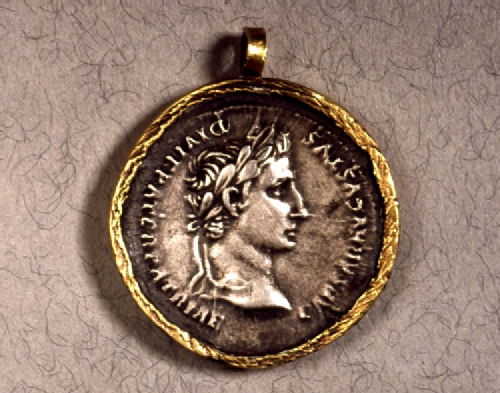 |
|
Coin of Augustus used as a pendant © The Trustees of the British Museum |
But self-display was not the sole reason why an individual would choose to transform coins into jewellery. Nor can it simply be explained as a fashion, since fashions change and our evidence for coin pendants spans hundreds of years. A study of the iconography of the coins chosen for this purpose suggests that not just any coin would do. Generally our examples are drilled to allow a chain to pass through, or else a loop attached, and the location of this tells us which way the coin was intended to hang. In most cases the coin was orientated to display the obverse, most tellingly, the image of the emperor. For example, the coin pictured here is orientated to display the diademed profile of Augustus. This coin was minted in 2 BC and its use here celebrates the reign of Augustus. Thus one could argue that coin pendants projected a political as well as social message. The modern day transformation of the ‘Gloria Exercitvs’ coin follows this ancient precedent, but this time the choice was motivated by aesthetic value rather than a desire to make a political statement of allegiance to the emperor.
It is debatable whether the Roman jeweller was motivated by the aesthetic, political or social potential of coinage when they set about incorporating coins into jewellery. Clearly, these artefacts pose questions about the nature of Roman society and the nature of its value system; and since coin pendants remain popular today we could trick ourselves into believing that we are not so different from the Romans after all.
 This month's coin was chosen by Eve Bayram. Eve graduated from Warwick in 2014 with a degree in Classical Civilisation. While at Warwick Eve focused on the study of Latin literature, and her disseration was entitled 'Self-presentation in the Latin epistolary genre: Cicero, Seneca, Petrarch.' She is currently interning in the dictionaries department at Oxford University Press.
This month's coin was chosen by Eve Bayram. Eve graduated from Warwick in 2014 with a degree in Classical Civilisation. While at Warwick Eve focused on the study of Latin literature, and her disseration was entitled 'Self-presentation in the Latin epistolary genre: Cicero, Seneca, Petrarch.' She is currently interning in the dictionaries department at Oxford University Press.
April 01, 2014
The "King of the Britons" Coin
 |
| Coin of Cunobelinus |
Before the invasion of Britain in AD 43 by the Roman Emperor Claudius, we have very little information on the earlier rulers of Britain. Classical accounts speak of only a few British chieftains, so our main source of evidence as to who these rulers were comes from the coins minted by the British kings themselves. Therefore this month’s coin belongs to Cunobelinus, a tribal leader active in South-western England from around AD 30.
This British coin is quite similar to its Roman counterparts. It uses a depiction of a head on the obverse similar to that of the Roman Emperors on their coins, and on the reverse a centaur is depicted. The centaur is a Greek mythological creature, and not part, as far as we are aware, of the pre-Roman British mythology. The use of Greek and Roman imagery was fairly common in this period, but it represents a new design of British coins. Horses had been very prevalent on coins, inspired by Macedonian coinage, but designed in such a local, British way, that they look very different from the depictions of horses in the Greek and Roman worlds. The designs on this coin indicate increased awareness of Roman styles, representing a stronger connection to the Roman world. As a bronze coin, this coin is unlikely to have been used for trade with the Romans, who traded in silver for the most part, although it is possible the ideas expressed on the coins were communicated to the Romans through a different medium. Thus the imagery is more likely to have targeted Cunobelinus’ British subjects. Wine amphorae from Rome have been found in elite burials in this period, indicating there was increased contact and trade with the Romans, and that the British elite were starting to adopt Roman customs. A ruler who was also interested in Roman designs would thus be more favoured as a leader. Thus even before the Roman invasion, the British were already adopting Roman customs and art styles. It was not “forced upon them” by the invading Romans.
Nonetheless, despite the increased interest in Roman culture, the centaur is a strange image to use, seen rarely on other coins even in the Greek and Roman world. The legend on the reverse reads “TAS…ONI…” (TAS[CI]OVA[NIF]), a reference to Tasciovanus, Cunobelinus’ father. Thus perhaps the centaur is being directly associated with Cunobelinus’ father. In Greek and Roman mythology, the centaur is often representative of drunkenness and barbarianism, not an ideal fatherly representation, so perhaps the British saw the centaur in a different way. The British had great veneration for horses, often depicting horses on their coins, so they were clearly a symbol of significance. They were probably representative of power, as horses are strong animals, and they also communicated wealth, as to own a horse costs a lot of money. Therefore a centaur, as a hybrid of horse and man, in British eyes may have represented a man being combined with this powerful creature. In this way, perhaps Tasciovanus is being displayed as the centaur, as a man with the great power and wealth associated with a horse. In this way, Cunobelinus depicts his ancestry as great, which would have made him popular with his people.
Some scholars have seen the Roman head on the obverse as representing the Roman Emperor, and thus the coin is designed to praise the Roman leadership. However, with the legend of “Cunobelin…” nearby, it seems the head is actually representative of Cunobelinus himself. Why he chose to do this can be seen in the Roman biographer Suetonius’ account. He states that the Emperor Caligula received the surrender of Adminius, who Suetonius describes as “Cynobellini Britannorum regis filio”: “the son of the king of the Britons, Cunobelinus” (Suetonius Caligula 44.2). Suetonius’ description seems to indicate that Cunobelinus ruled all the people in Britain, when in reality it was made up of many different tribes, each controlled by their own king. Either Suetonius has got his facts wrong, or perhaps he is buying in to Cunobelinus’ propaganda. There is no British equivalent of an Emperor, a man in charge of a huge amount of lands and tribes, so perhaps Cunobelinus is taking the imagery of a Roman Emperor in order to give the impression that he is even more powerful than just an average tribal chieftain, making him appear the most powerful man in Britain. In fairness, this may not be too far from the truth, as some scholars believe that during his reign, Cunobelinus was acquiring new territory in the South of Britain, so he may have needed to prove he was worthy of this large portion of land. While Cunobelinus probably was nowhere near the sole ruler of Britain, his representation of himself as an Emperor could well have convinced some Romans, as seen in Suetonius’ account, that he was, or at least a major player in British politics. This would help immensely to encourage trade, as Roman traders may have been deceived into seeing Cunobelinus as the most powerful, and thus the richest man in Britain, and thus the best person to go to with their desirable wares.
 This month's coin is chosen by David Swan. David is currently an undergraduate student of Classical Archaeology and Ancient History at the University of Warwick. His interests include numismatics, and prehistoric Britain.
This month's coin is chosen by David Swan. David is currently an undergraduate student of Classical Archaeology and Ancient History at the University of Warwick. His interests include numismatics, and prehistoric Britain.
(Coin image above reproduced courtesy of Classical Numismatic Group Inc., (Mail bid Sale 66, lot 46) (www.cngcoins.com))
March 01, 2014
A gold octadrachm of the Ptolemaic Dynasty
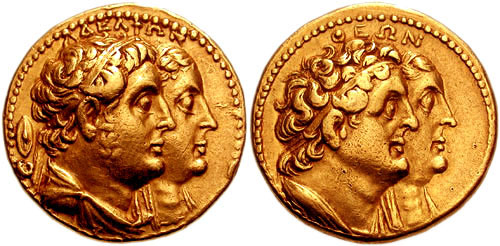 |
| Octadrachm of the Ptolemaic Dynasty |
This gold octodrachm was struck at the mint in Alexandria in Egypt, probably under Ptolemy II (this series was likely introduced under Ptolemy II, and was struck until Ptolemy V). The obverse jugate portrait busts are that of Ptolemy II and his sister-wife Arsinoë II (philadelphoi). Both heads are diademed, with that of Arsinoë probably veiled (it is a little difficult to tell). Both busts have a chlamys. The legend within an off-centre dotted border reads ΑΔΕΛΦΩΝ (adelphon), a genitive plural meaning ‘of the siblings’. The reverse depicts the jugate busts of Ptolemy I and Arsinoë I (Soteroi), the parents and predecessors of the obverse subjects. Again, both are diademed and are wearing a chlamys. The legend within the dotted border reads ΘΕΩΝ (theon) meaning ‘of the gods’. This coin presents us with two generations of the Ptolemaic dynasty of Egypt represented on one coin. In light of Ptolemaic iconography up to this issue, this octodrachm is unique, contributing to the on-going iconographic development of Ptolemaic image and ideology.
It was not the everyday bronzes which carried the vanguard iconography of royal ideology, as Ptolemaic bronzes are markedly more conservative and conventional in their iconography, limited to a head of Zeus on the obverse and an eagle on the reverse. Nor are silver types particularly innovative, as they tended also to be similarly iconographically consistent. The more radical and innovative ideological presentations seem reserved, at least early in the Ptolemaic dynasty, for gold issues. From this octodrachm we recognise the preoccupation with retroactive referencing to previous sovereigns and predecessors. But there is also a horizontal reference, in the inclusion of wife and sister, placed behind as they are, but tellingly also parallel to the king. Their co-ruling is suggested, as is the influence of the Ptolemaic queen within the royal court. Familial undertones also come through, with insinuations of loyalty, and secure dynastic succession derived from strong familial bonds. In relation to the ruling king, this reinforces the image of legitimacy in his kingship. The near-identical jugate portraits possess a regal bearing; the duplication betrays aspirations of wanting to be seen as an established royal house. As subjective in interpretation this type may be, they are the result of generations of (generally) dynastic development and (particularly) developments in coin iconography. This process was continued little by little, in experimenting with new ideas of imagery, and ways of presenting and announcing those images, one attribute at a time.
This month's coin was chosen by Sean Gallagher. Sean Gallagher is currently an undergraduate student of Classical Archaeology and Ancient History at the University of Warwick. His interests include religious and cult continuity, numismatics and New Testament Greek.
(Coin image above reprpduced courtesy of Classical Numismatic Group Inc., www.cngcoins.com)
 Clare Rowan
Clare Rowan

 Please wait - comments are loading
Please wait - comments are loading
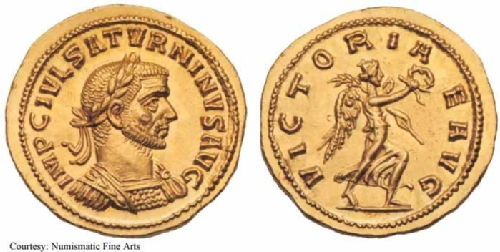

 Loading…
Loading…

